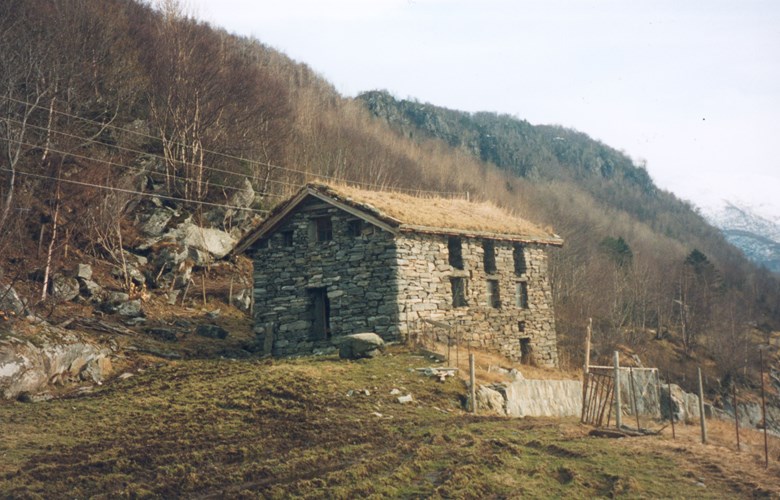House with a commanding view
At Åsnes we find a house that is completely built of stone from its foundation up to the roof ridge. Malvin J. Aasnes (born 1882) spent many years building this house. Malvin was originally from Kroken to the west of Bryggja. In his younger days he went to America, but returned when times were bad. He married and took over the holding of Nedreberg at Åsnes, which is a small farm in a steep terrain between Bryggja and Lefdal.
When Malvin came to Åsnes, the area consisted only of outlying fields near the lighthouse at Åsnes. But it was there that he wanted to live. The place had a commanding view in all directions. From the old houses on his farm he could only see across the fjord to Endal. Malvin started to cultivate a field at the headland in his spare time. He saved the stone that was suitable for wall building. In wintertime he dragged the stones to the site he had picked out for his new house. He had made himself a small sledge for this purpose. He did not have a horse. The stone that could not be used in the building of the wall he put in the deepest spots in the terrain and levelled it off with soil. In this way the field became more level.
Lifted by hand
When Malvin had dragged and piled up a suitable number of stones, he started on the wall building itself. Everything went fine at first when the stones did not have to be lifted so high. As the walls became higher, however, the job of lifting the stones became much harder. Malvin solved this problem by making some wooden poles that he placed at an angle up against the wall. On these poles he dragged the stones up by hand. As the work progressed, the toil of dragging the stones up became more and more heavy. Malvin had planned to build the house in two full storeys. The ground floor would be used for a barn and cowshed, or a storage room for hay. Under the part of the planned barn, a basin wall was first built for manure. The first floor he wanted to use for his family. The gable ends were stonewalled all the way up to the roof ridge. In the attic there was space for more rooms.
The dream and the determination
Malvin was married but they had no children. His wife came from Skavøypollen. Malvin was a hard-working man, and most of his time was spent running the farm and trying to eke out a living. People remember that he used to wear a jute bag on his back as a protection against the rain. He did not have any oilskin clothes, and a little rain did not keep him from working outside. Malvin did some salmon fishing as well. He worked on his stone house in his spare time, but time and old age prevented him from making his dream come true. When Malvin came to the old people's home at Bryggja, the stone house was completed as we see it today, but he never got the chance to move in. Malvin died at the old people's home at Bryggja. The stone house at Åsnes is sometimes referred to as the stone castle at Åsnes. The house is a testimony to determination, work capacity and dream. The story of the stone house makes an impression on us. The house today stands as a memorial to Malvin J. Aasnes, his dream and determination. In 1988, the house had no roof, but later a turf roof has been laid. Today there is a road leading to Åsnes.

